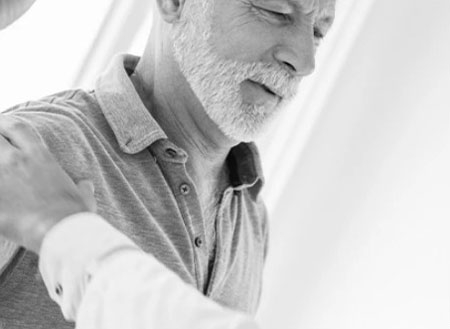
In the world of joint replacement surgery, the shoulder often flies under the radar. Hips and knees steal the spotlight, but the advancements made in the realm of shoulder replacement render it an excellent surgical intervention for shoulder pathologies. The shoulder is a complex joint partially because it is of the ‘ball and socket’ variety, meaning that it moves and functions in a myriad of different directions rather than, say, a knee that primarily moves forwards and backwards. The shoulder joint is composed of the upper arm (or humerus bone), the clavicle (or collarbone), and the scapula (or shoulder blade). These bony structures are given stability by the rotator cuff, which is composed of four different muscles: the supraspinatus, infraspinatus, teres minor, and subscapularis. These muscles work together to provide stability to the shoulder while still allowing it to move multi-directionally. The unique aspect of a shoulder replacement is that two different types of replacement exist: a traditional total shoulder replacement and a reverse total shoulder replacement.
A traditional total shoulder replacement is performed when the ball and socket of the joint is damaged or arthritic and causing the patient significant discomfort or loss of function, but the integrity of the rotator cuff is maintained. Arthritis results from past injuries, surgeries, or trauma, chronic wear and tear on the joint, or even genetics. During this surgery the natural ball of the joint is removed, a canal into the humerus bone is made, a stem is inserted, and then a new ball is placed. A new socket provides a smooth surface on which that replaced ball can move without aggravation.
Alternatively, a reverse total shoulder replacement is preferred when damage to the rotator cuff is present. Because the rotator cuff provides stability, when it is worn out the artificial structures of a shoulder replacement could sustain damage if adjustments are not made. A reverse shoulder replacement switches the location of the ball and socket so that the artificial socket is placed on the moving humerus where the natural ball was and the artificial ball sits on the stationary scapula where the natural socket originated. This technique allows the shoulder to move safely through a range of motion.
These surgeries, like most surgeries, have an abundance of variables that are specific to each individual patient. Considerations are made for a patient’s age and activity level, bone health, and specific pathology. Such considerations include the size of the implant as well as whether it is metal or plastic or a combination thereof. At your surgical consult, your board-certified surgeon will take time to discuss the nature of your condition and what option will provide you with the best possible outcome.
These surgeries have seen a great success rate for our shoulder specialists here at Orthopaedic Associates of Wisconsin. If you find yourself living in the greater Milwaukee and Chicagoland areas with persistent shoulder pain keeping you from your daily activities, come see us to determine if one of these procedures is right for you! In the meantime, if we have peaked your interest regarding the nature of these surgeries, our very own Dr. Papandrea has put together a short video you can peruse at your leisure below.
This blog is written by one of our very own-Morgan. She is a certified athletic trainer working as a medical assistant with our providers each and every day in our clinic. She obtained a bachelor's degree in athletic training from Carroll University in Waukesha and a master's degree in Kinesiology from Michigan State University. She is excited to bring you updates and information about the happenings at OAW.

